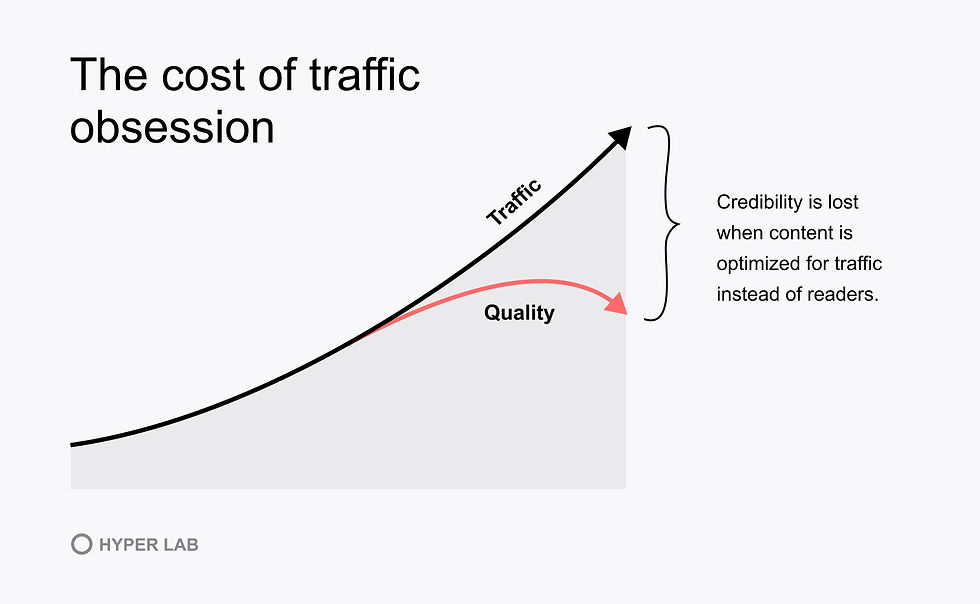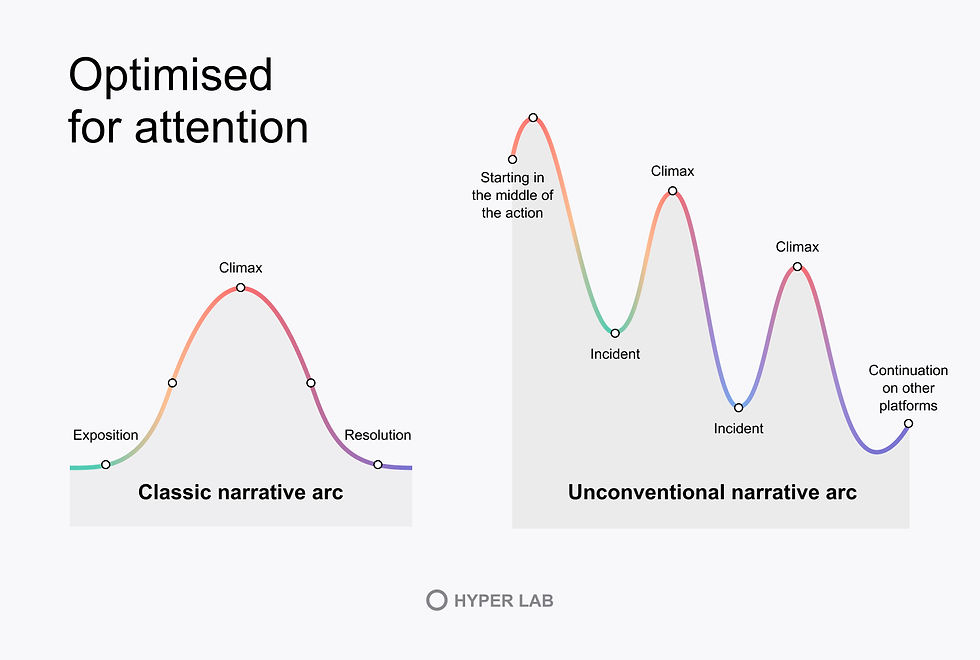ATTENTION MATTERS MORE THAN TRAFFIC
- Alexandra Dimofte
- Aug 16, 2024
- 5 min read
Updated: Jul 7
Repetition is the problem, unpredictability is the solution

It's easy to forget that traffic is not an end in itself. And once we realize that, it's tempting to think the goal must be sales. But in any market, at any given time, only about 5% of consumers are ready to buy now, while the other 95% aren't interested in the company or its products. But they will be.
Until then, the goal of marketing communications is to secure the right spot for the brand in people’s minds. However, long before shaping memories, associations and emotions that influence buying behavior, most marketing materials hit the same wall.
They fail to capture and hold attention long enough to be remembered. Dr. Karen Nelson-Field, a globally renowned media science researcher, analyzed 130,000 ads and found that 85% of them received less than 2.5 seconds of active attention and had zero chance of being remembered. They generated views and clicks, but did nothing to build the brand and influence future sales.
When data pushes us in the wrong direction, the risk of wasting the marketing budget becomes a certainty. Misguided decisions are celebrated. Failure is mistaken for success. Just look at the websites that rank on the first page of Google, generate massive traffic, and are forgotten the moment the tab is closed. Traffic does not equal brand awareness, and when we’re targeting the 95% of customers who aren't in-market, the distinction is important.
When success masks failure
In performance marketing, we ask consumers if they want to buy. In brand marketing, we ensure the answer is “yes”. We aim to grow brand awareness, build trust, and increase the chances of being chosen in the future. But since most companies don’t conduct market research, the questions that truly matter go unanswered.
Without brand tracking data, proxy metrics become the only way to read the market and in digital marketing, there’s no shortage of these metrics that measure one thing but correlate with something else. Traffic correlates with brand awareness, referral traffic with reputation, social media followers with popularity, engagement rate with content quality, and the model works perfectly fine until companies start making decisions to improve the metric rather than what the metric is meant to represent.
To increase traffic, they publish more often, stuff in more keywords, or shout louder with a clickbait headline. To increase time-on-page, they stretch 800 words into 3,000. To generate leads, they bombard their audience with ten versions of the same ad, all equally bland.
What looks like gold for performance may be plutonium for credibility. The tactics that boost proxy indicators the most are often the ones that risk frustrating the audience the most. But frustration doesn’t show up in the dashboard, so it’s easy to forget that marketing is also a game of perception, and many companies are losing.

Most of the time, the hundred SEO texts written with ChatGPT don’t even have fans within the company publishing them. “We don’t like them, but they bring us traffic” captures the dilemma of the marketer who understands both what they’re gaining and what they’re losing when their tactics do not align with their customers’ interests. They know that traffic doesn’t reflect the whole picture, but the certainty of numbers is tempting. And analytics platforms sell certainty.
Dressed in the illusion of “informed decisions”, the goal of marketing is no longer to bring people closer to the brand, but to optimize numbers. And inflating those numbers pulls companies further from reality until reality pulls them back, hard.
Defeated in the attention economy
“An abundance of information creates a scarcity of attention”, concluded Nobel laureate Herbert Simon, who in the late 1960s gave the world the concept of the “attention economy”. Simon, whose cross-disciplinary work laid the foundation for behavioral economics, organizational psychology, and artificial intelligence, was the first to recognize that the growing flow of information was, at its core, an economic problem.
Seen through this lens, market dynamics become clear. The more media noise there is, the more selective audiences become in allocating their attention. The more ads we see, the more we learn to avoid them. As content volumes grow, so do our habits of skimming, watching for just a few seconds, scrolling endlessly, ignoring, and forgetting.
The public learns to ignore the noise and tune into the clean signal. While some content creators complain about the declining attention span, others enjoy the rise of binge-watching. While some authors remain obscure, others are read again and again. While most receive only a sliver of attention, a few earn a lot more — a place in the audience’s memory, preferences, and habits.
Lucas Hulsebos, CEO of market research firm DVJ Insights, explains that failure to capture attention usually stems from three reasons: consumers don’t like what they see, the marketing material is irrelevant or the approach is far too common. In 8 out of 10 cases, brands lose the audience’s attention because of that last reason.
Whether we’re watching an ad, reading an article, or walking down the street, our minds are constantly making predictions about what will happen next. When those predictions are proven wrong and something unexpected occurs, attention is activated and the brain becomes ready to absorb new information.
For mass media and marketing, this means that, for example, a chatbot generating text based on statistical probabilities cannot grab our attention. Nor can a story we've heard a hundred times, told from the same angle, in the same way. Repetition is the problem. Unpredictability is the solution. But how that unpredictability is built depends on the media channel.
On television, the traditional narrative arc where tension builds gradually to a climax is still relevant. But TikTok changes the rules: time is condensed, the story structure is flipped, and attention is earned by starting with the peak moment.
At the crossroads of binge-watching and bite-sized content, YouTube pushes us toward a hybrid approach. The platform encourages advertisers to experiment with ads that start strong but follow unconventional narrative arcs, with twists, conflicts, and multiple peaks precisely because attention on YouTube is very volatile.

Ads that follow unconventional narrative structures on YouTube have a viewing time four times longer than those that follow the classic structure. However, optimizing for attention is equally important for all communication tactics.
From writing a video script and developing a podcast format to simply arranging questions in an interview plan, the final test is always attention. Those who pass it gain the chance to be remembered. Those who don’t are filed away in the recycle bin of memory, waiting to be deleted.

